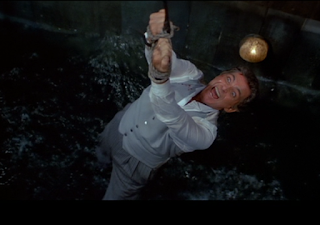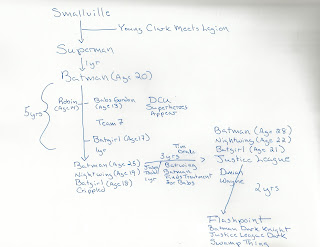Pick of the Brown Bag
June 22, 2016
by
Ray Tate
Greetings, and welcome to the Pick of the Brown Bag, a weekly review blog of comic books. I’m Ray Tate, your cruise director to reviews of Action Man, The Adventures of Supergirl, Aquaman, James Bond, Justice League, Red Sonja, Thor, Tomb Raider, Ultimates. Teensy-tiny versions of my reviews can be found on Twitter: #PickoftheBrownBag.
Dan Jurgens produces an all Lex Luthor issue of Justice League that's far better than Action Comics. Of course, it would have to be. The story is mediocre with a few moments of dramatic potency as well as silliness. So that's a testament to how bad was Action Comics. Mediocre with excellent art by Tom Grummett, a group of talented inkers and colorist Gabe Eltaeb trumps lousy on multiple tiers. I still can't recommend Justice League unless you're nuts about Lex, but there's much worse out there.
Superman's secret identity was blown a few story arcs before his death. Seeing how Superman's parents are twice dead, Perry White assumes the role of foster father and displays his son's cape in the lobby of the Daily Planet Building.
Superman's cape should be in the Smithsonian or at his mausoleum not at the Planet. Even if you think you're the family of Superman, Superman belongs to the world. I have no doubt that Perry's heart is in the right place, but there's a conflict in creating an instant tourist attraction. Take the Justice League for instance.
Here's where Justice League differs from Action Comics. Rather than pick a fight for no reason at all and endanger innocent people, the Justice League talk to Lex because he's one of them. Oh, sure. They may not like him, but he's one of them. In which case, Jurgens turned Superman from Another Universe into a sphincter on purpose. He's wrote Action Comics. He writes Justice League.
The League's willingness to converse immediately ticks the book up a notch. Lex's discussion with his comatose sister Lena, a former Darkseid minion, also raises the book farther above the level of crap.
Lena is not a new character. She entered the Superman Mythos in Lois Lane #23 decades ago and has been on again off again in almost every era of comics as well as Smallville.
The rest of Justice League is dismissible. Lex stops a robbery, uses his armor to withstand minor retaliation, with respect to super-heroes and threatens a hood in a steal from Batman...
Batman #423
Lex then buys The Daily Planet to acquire the cape. The Daily Planet passed through Lex Luthor's hands before, but his ownership was part of a major storyline. This purchase not so much. Buy The Planet, take the cape in a completely perfunctory move.
Once again Aquaman stands out. Aquaman seeks Atlantis' recognition as a nation. To that effect he has created Spindrift.
The trouble is that Black Manta still hates Aquaman. Aquaman killed Manta’s father, long ago.
Aquaman #10
The circumstances argue for manslaughter, sentence commuted due to community service. Black Manta's motive is understandable. His utter abhorrence of Aquaman cannot however excuse the death and destruction he causes. His blind callousness makes him a villain.
Writer Dan Abnett unfolds the story at a splendid pace, marked by a definite passage of time. In Aquaman's lighthouse home, Aquaman awakens with Mera. The couple discuss their thoughts on the new era for Atlantis. Any writer might have done that, but where Abnett differs is that he neatly meshes the love Mera and Aquaman feel for each other with the main plot.
The opening of the Embassy to the world's representatives lacks the pomp and circumstances you expect. Instead, Abnett opts for a quieter onset framed by character studies and some honest to goodness wit.
When Manta attacks, hidden amongst the guests, the story shifts into emotionally-fueled action. Mera seeks to save the innocent under threat in a brilliant display of power and Aquaman in a masterful depiction by Brad Walker responds to Manta with a trident.
The next best thing amongst the contenders is no surprise. Bond, James Bond.
In this latest tale, writer Warren Ellis reintroduces Felix Leiter Bond's CIA colleague. Felix debuted in the very first Ian Fleming Bond novel Casino Royale.
He didn't premiere with the prosthetics. Ellis draws upon the Fleming work Live and Let Die which was partially recapitulated in the movie License to Kill, easily the most vicious of the James Bond films.
As you can see in the previous graphic, Ellis also ties the aftermath of the shark attacks from those works with events from previous issues of the James Bond comic book. In this way, James Bond is the perfect melange of James Bond media. Felix the ideal representative.
Shortly, the reader discovers why Bond meets Felix in a Los Angeles airport. Bond’s assignment is one of simple asset extraction. The task should be as much of a milk run as Bond's simple investigation into the disappearance of Dr. Strangways in Dr. No. I trust I need not elaborate.
It turns out that the agent, a forensic fiscal detective, by following a money trail tumbled a mole within the CIA, who we see memorably in the prologue.
Before Bond addresses the enigma, Bond must deal with Turkish assassins bent on ending his fellow British spy's simple life. Needless to say, Bond metes out impressive violence and engages in race car driving indicative to the world not enough created by Ian Fleming and propagated in the films. However, it is unlikely Bond's boss M will be impressed.
Bond's gun remarks constitute an intriguing political environment that Ellis utilizes to construct new obstacles for Bond. These additions also allow for curses to be lodged at bureaucrats, frequently the paper entrenched enemy of Bond no matter the work.
However, Ellis doesn't want the reader inventing political opinion for him. He faultlessly incorporates an argument against NRA puppetry into Bond's character. You can use a gun, even need them and still not be fan of the lawlessness of the United States. I doubt very much Bond would look upon the gun lobby as an ally.
Action Man is weak tea James Bond. The original Action Man as seen in the free Rom comic book from IDW dies. His protege takes his place.
Ian Noble is brash and newly trained. The story takes him to a dirty bomb hostage crisis which he handles like the blunt instrument James Bond is accused of being. He next infiltrates an old Action Man headquarters started by Victor Hugo of all people with the mission of Action Man intel elimination. Ian changes the parameters when the killer of the original Action Man Dr. X leaves his mark.
Tomb Raider on the other hand is the spiritual descendent of James Bond. On a quest to discover a mushroom that supposedly grants eternal life, Lara Croft attempts to negotiate a series of caverns and survive a strange group of men also seeking the fungi.
Varied with violence and packed with daring escapes as well as archaeological digs, pun intended, this is easily the best Tomb Raider series I've read.
Red Sonja concludes magically and mythically. This latest series of the She-Devil with a Sword was flawed in terms of plot and not entirely my cup of tea, despite the artwork being stunning. However, it's a perfectly valid interpretation of Red Sonja because no treatment in the comics ever accurately depicted the character from Robert E. Howard's "Shadow of the Vulture."
The Mighty Thor drops the spotlight on Darrio Aggar Minotaur and Roxxon CEO. Aggar must answer to Marvel's Blinderberg Group, which consists of the movers and shakers of criminal corporate.
Unlike the real life clique, the Marvel versions share in the pie. So they're a little perturbed that Aggar opened up mining in the Elven Realms without giving them a taste. To that end writer Jason Aaron does something rather surprising with his villain, especially given the remarkable build up in characterization.
By now, you should know who Thor is. If you still haven't learned of the new Thor's identity you can stop reading this review right now. I'll be spoiling the months ago reveal in the very next paragraph. You have been warned. Just accept my word that this is a most interesting issue of The Mighty Thor and worth your time.
While Thor's foe Aggar tries to explain himself to the board, Jane Foster faces SHIELD problems. In a semi-comical episode, Aaron demonstrates the two factions of SHIELD.
One is the shitty group probably run by Maria Hill, but the other is Coulson's team. You can identify them easily. They're wearing the classic SHIELD garb and driving around in hover cars.
Aaron begins to forge a friendship between Roz Solomon and Foster that looks to be honest and enjoyable to read, but once Jane gets wind of the events in Sweden, it's hammer time.
The latest issue of Mighty Thor gets back on track, with the team of Aaron and Dauterman thankfully again combining forces. Although the events of Vote Loki get a mention, primarily the creative team return the story back to the exploitation of the Nine Realms by Terran criminals and the Dark Elf Lord Malekith. At the same time they complicate the life of Jane Foster and the Mighty Thor.
Previously, Supergirl fought a kind of Dream Warden named Psi. She protected the dreams of the numerous alien prisoners on the Kryptonian correctional edifice Fort Rozz. Fort Rozz for those not in the know crashed on earth and provides the monster-of-the-week moments for Supergirl.
Psi did things like calm Rampage, whom Supergirl fought in another issue. Rampage, created by John Byrne, in this continuity is an alien, not Kitty Faulkner, STAR physicist. Supergirl made a promise to Psi. Like most "ghosts" science fiction and otherwise, Psi cannot pass until her body is consecrated.
So, Kara and Alex, Supergirl’s human foster sister, take a road trip to the site of Fort Rozz’s crash. Naturally, things don’t go as planned. Though free of debris thanks to DEO involvement, Supergirl detects a whole Kryptonian shelter that the organization missed. This is an acceptable error. The Kryptonians were far more advanced than human civilization. If anybody could hide a headquarters it would have been someone from Kara's species.
What sets this story above a standard Supergirl musing is the wonderful dynamic between Supergirl and her sister. Writer Sterling Gates reiterates the performance of Melissa Benoist and Chyler Leigh. Likewise, artists Carmen Carnero and Sandra Molina do an excellent job bringing the actresses performances to the pages; this includes quiet moments and when Supergirl unleashes her might.
Supergirl's target for this issue is Facet. The mystery being is a completely new creation by Gates and Carnero. Though perhaps she has a loose Legion of Super-Heroes connection. Facet is dangerous for a number of reasons. One, if she's not a Kryptonian, she has close ties to Kara's people. Two, her invulnerability levels out Kara's strengths. Three, she expresses little regard for humans. Four, she doesn't actually consider herself the enemy. Her purpose for luring Kara down to her home is loaded with intriguing possibilities.































































